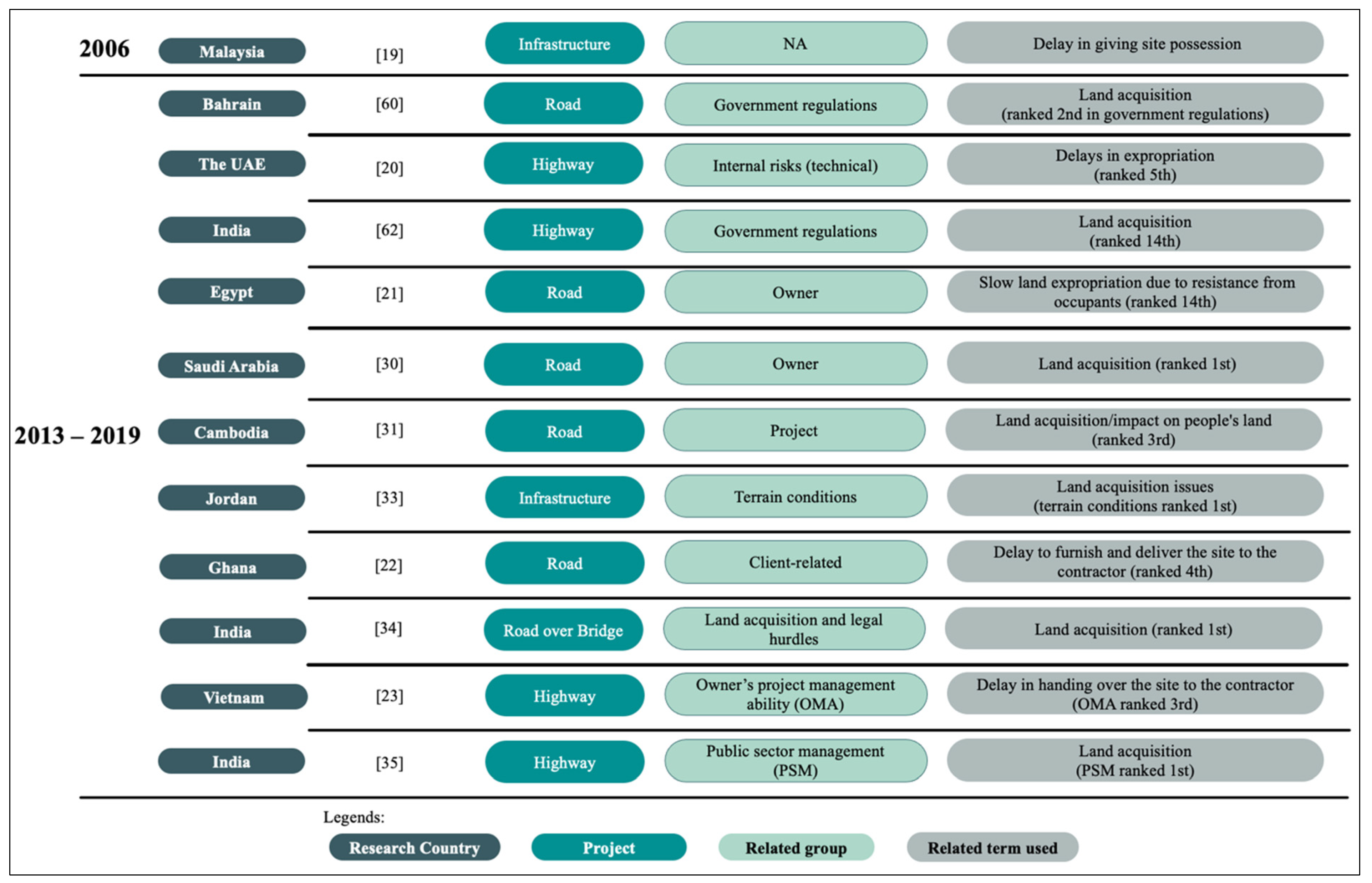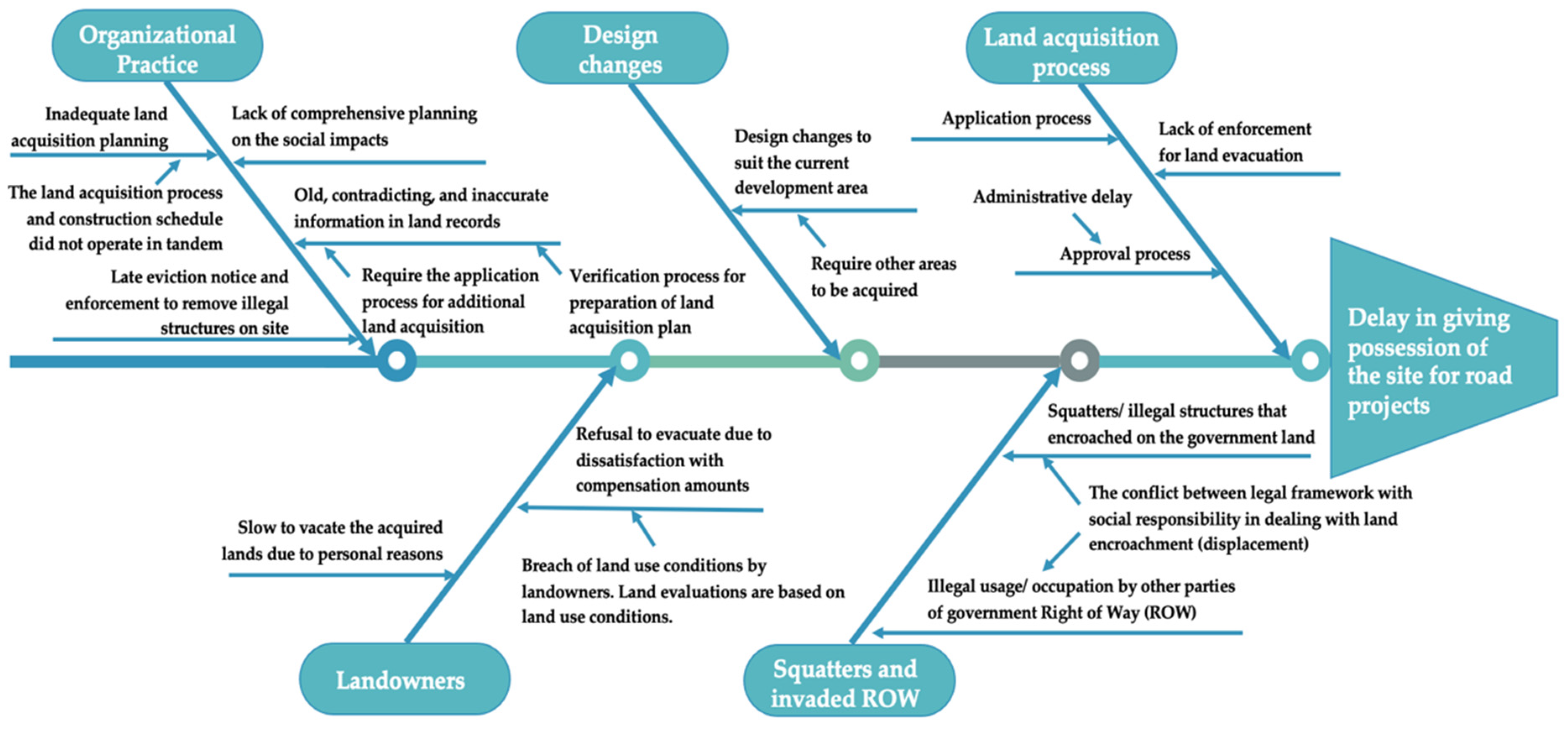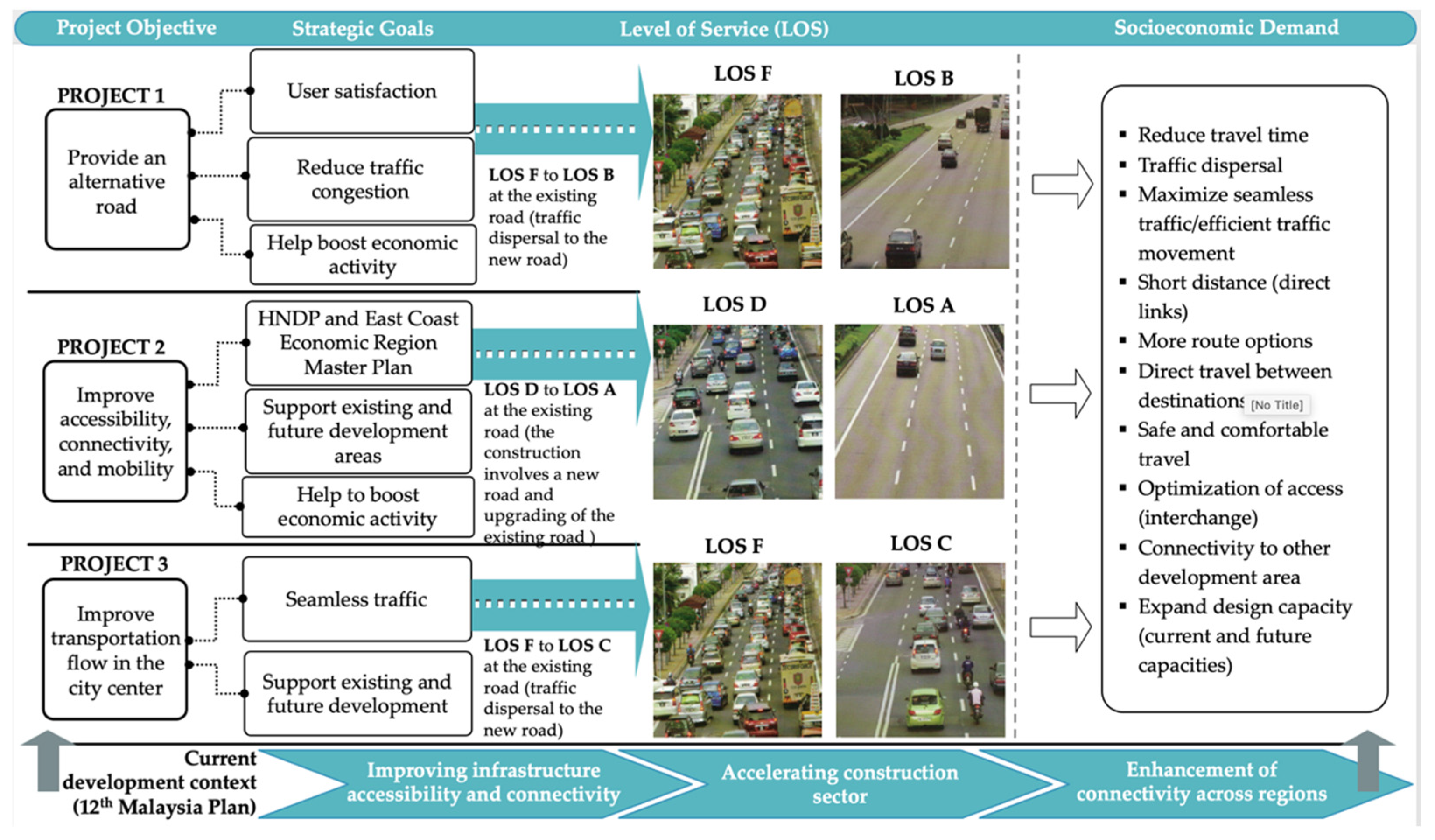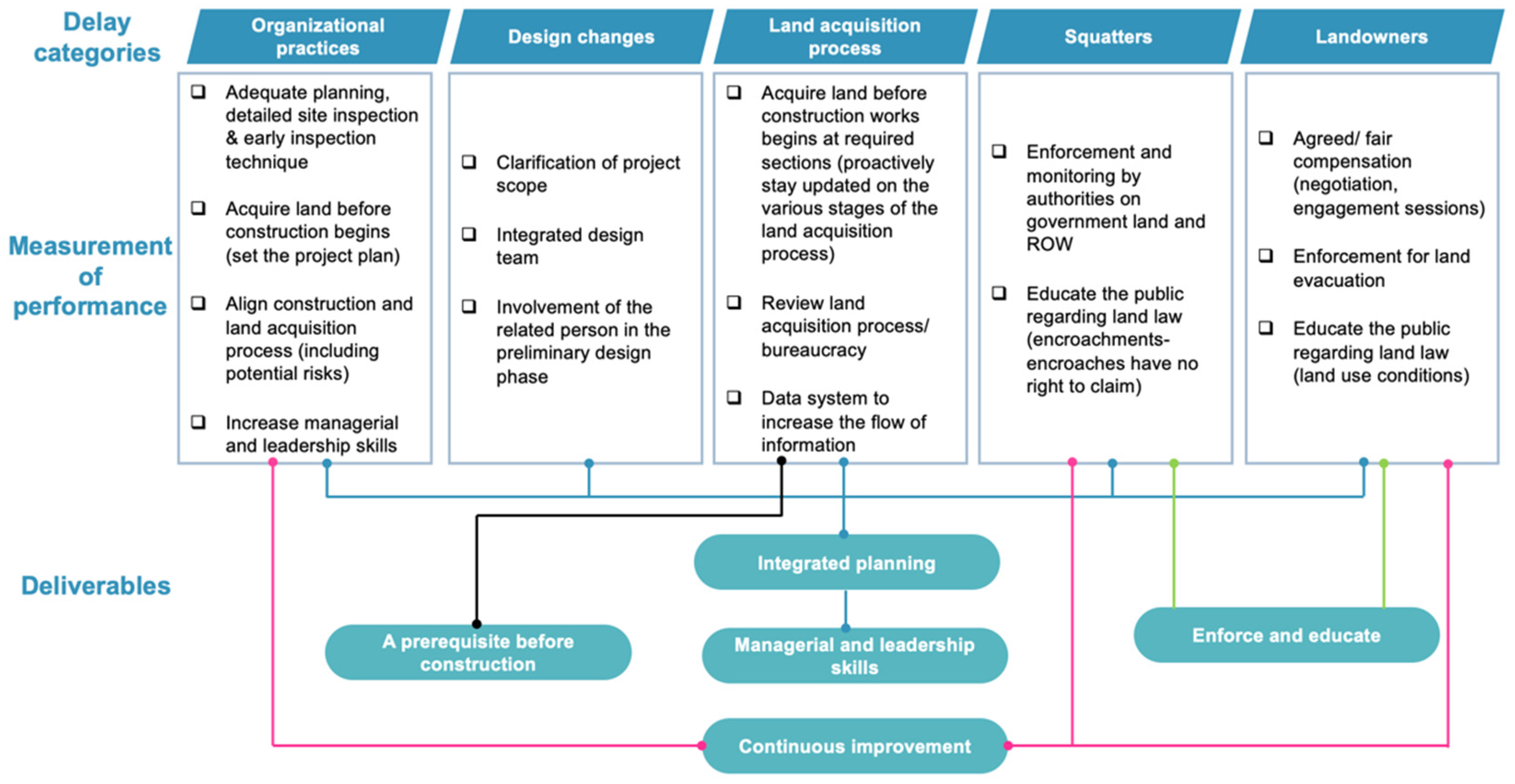Possession of Site: Another Layer of Complexity in Road Construction
Abstract
1. Introduction
- Question 1: Which causes dominate delays in giving site possession?
- Question 2: What are the impacts of site possession issues for road construction projects?
- Question 3: What strategies can the client and construction practitioners apply to mitigate delays due to site possession issues?
2. Literature Review
2.1. Site Possession in Construction Contract
2.2. Delay in Giving Site Possession in Road Construction
2.3. Impacts of the Delay in Giving Site Possession in Road Construction
2.4. Adoptions of Mitigation Strategies for Site Possession Performance
3. Materials and Methods
3.1. Research Methodology
- Selecting, coding, and categorizing the data of the delay causes through real project cases;
- Displaying the data in the form of an infographic table and a diagram illustrating the data’s patterns in order to assist the authors and readers in comprehending the data. The table includes the extended time durations due to the delay in giving site possession. Meanwhile, the diagram summarizes the causes of delay under five categories. The categories are based on the frequency of reasons identified from the project data. These categories are the following: organizational practices, design changes, land acquisition, landowners, and squatter- invaded right of way (ROW);
- Discussing three projects for detailed elaboration on the identified causes of the delay in giving site possession and its impacts.
3.2. The Case Studies
4. Analysis and Findings
4.1. Causes for Untimely Site Possession and Its Impact on Time Performance
4.1.1. Organizational Practices
4.1.2. Land Acquisition Process
4.1.3. Design Changes
4.1.4. Squatters
4.1.5. Landowners
5. Discussion
5.1. Time Performance
5.2. Cost Performance
5.3. Suppression/Limitation of Socioeconomic Demand
5.4. Development of a Conceptual Framework of Site Possession Performance in Road Construction Projects
- Integrated planning should occur to prevent miscalculations. Preliminary and adequate planning is crucial to deter construction-related changes. The number of affected properties and businesses, squatters, kiosks, and informal developments on the specific land must be identified for land acquisition and resettlement issues [44]. Better clarification of scope in the pre-acquisition phase is essential toward reducing design changes, and a related person must be included in the preliminary design phase [25]. Road construction project planning should also correspond to land acquisition processes in line with construction plans [28];
- Establish a prerequisite before construction begins. Clients play a significant role in giving site possession, and land must already be acquired before the construction process [27,69] or site delivery after the award of a project. Regardless of the urgency in executing a road construction project, land issues must be considered to ensure contractors enter the site and perform their contractual obligations. The amount of bureaucracy involved in the land acquisition process could be reviewed to expedite the process [19];
- Legal conflicts should be prevented in a socially accountable way through enforcement by authorities to resolve land-oriented complexities [14]. The state governments and relevant authorities should draw the obvious lessons from this study to fully implement the law for minimal squatter issues, such as social and environmental concerns. The government seeks to respect the legal framework and social responsibility norms at the same time. Thus, it is challenging to deal with this complex set of circumstances. At the same time, illegal occupiers receive political patronage [40]. The government, or entities familiar with the law, such as the National Land Code 1965, should educate the public about the breach of land use conditions and encroachments on government land. People must understand that encroachers have no claim to the government land, and landowners cannot debate or protest the land use conditions;
- Construction practitioners should possess competent managerial and leadership skills. Following literature on significant leadership–project performance correlations [72,73], competent leaders catalyze communication processes and information flow with a clear vision [71]. For example, competent leaders could fulfill project plan requirements, offer creative problem-solving skills, and implement work plans in line with pertinent knowledge, experience, and networking. Notably, outcomes on road construction delays are positively related to project/construction managers’ experience, which significantly affects road construction projects [69,75];
- Soft skills, which include communication, teamwork, and critical thinking, should be incorporated into project management for continuous improvement in project implementation. Soft skills facilitate effective communication, negotiation, planning, design processes, social involvement, and consultation with the relevant parties [44]. It is worth involving landowners during the design and planning stage to facilitate their requirements better and ensure sufficient compensation [24,29].
6. Conclusions
Author Contributions
Funding
Informed Consent Statement
Data Availability Statement
Acknowledgments
Conflicts of Interest
References
- KKR. Highway Network Development Plan 2030; Kemeneterian Kerja Raya: Kuala Lumpur, Malaysia, 2020. [Google Scholar]
- EPU. Twelfth Malaysia Plan 2021–2025: A Prosperous, Inclusive, Sustainable Malaysia; Economic Planning Unit: Putrajaya, Malaysia, 2021. [Google Scholar]
- MOF. Ucapan Bajet 2022, Ministry of Finance. 2021. Available online: https://budget.mof.gov.my/pdf/2022/ucapan/ub22.pdf (accessed on 2 December 2021).
- Ellis, R.D.; Thomas, H.R. The Root Causes of Delays in Highway Construction. In Proceedings of the 82nd Annual Meeting of the Transportation Research Board, Washington, DC, USA, 12–16 January 2003. [Google Scholar]
- Geoghegan, L.; Dulewicz, V. Do project managers’ leadership competencies contribute to project success? Proj. Manag. J. 2008, 39, 58–67. [Google Scholar] [CrossRef]
- Coble, L.K. Real Construction Mitigation Case Studies. In Collaborative Risk Mitigation through Construction Planning and Scheduling; Emerald Publishing Limited: Bingley, UK, 2018. [Google Scholar] [CrossRef]
- Gadisa, B.; Zhou, H. Exploring influential factors leading to the poor performance of public construction project in Ethiopia using structural equation modelling. Eng. Constr. Archit. Manag. 2021, 28, 1683–1712. [Google Scholar] [CrossRef]
- Sambasivan, M.; Soon, Y.W. Causes and effects of delays in Malaysian construction industry. Int. J. Proj. Manag. 2007, 25, 517–526. [Google Scholar] [CrossRef]
- Shehu, Z.; Endut, I.R.; Akintoye, A. Factors contributing to project time and hence cost overrun in the Malaysian construction industry. J. Financ. Manag. Prop. Constr. 2014, 19, 55–75. [Google Scholar] [CrossRef]
- Yap, J.B.; Goay, P.L.; Woon, Y.B.; Skitmore, M. Revisiting critical delay factors for construction: Analysing projects in Malaysia. Alex. Eng. J. 2021, 60, 1717–1729. [Google Scholar] [CrossRef]
- Islam, M.S.; Trigunarsyah, B. Construction delays in developing countries: A review. Comput. Eng. Phys. Model. 2017, 7, 1–12. [Google Scholar] [CrossRef]
- Zidane, Y.J.T.; Andersen, B. The top 10 universal delay factors in construction projects. Int. J. Manag. Proj. 2018, 11, 650–672. [Google Scholar] [CrossRef]
- FIDIC Construction Contract, 1999 Red Book, For Building and Engineering Works Designed by the Employer, 1st ed.; International Federation of Consulting Engineers: Geneva, Switzerland, 1999.
- KKR. Roads in Malaysia; Hassan, A., Ed.; Kementerian Kerja Raya: Kuala Lumpur, Malaysia, 2011. [Google Scholar]
- Land Acquisition Act 1960, Act 486; International Law Book Services: Kuala Lumpur, Malaysia, 2020.
- JKR. PWD Form 203A, REV.1/2010; Jabatan Kerja Raya: Kuala Lumpur, Malaysia, 2010. [Google Scholar]
- Department of Statistics Malaysia Official Portal. Quarterly Construction Statistics, Fourth Quarter. 2021. Available online: https://www.dosm.gov.my/v1/index.php (accessed on 15 March 2022).
- JKR. Surat Arahan KPKR Bil. 34/2017; Jabatan Kerja Raya: Kuala Lumpur, Malaysia, 2017; pp. 1–3. [Google Scholar]
- Othman, A.A.; Torrance, J.V.; Hamid, M.A. Factors influencing the construction time of civil engineering projects in Malaysia. Eng. Constr. Archit. Manag. 2006, 13, 481–501. [Google Scholar] [CrossRef]
- El-Sayegh, S.M.; Mansour, M.H. Risk Assessment and allocation in highway construction projects in the UAE. J. Manag. Eng. 2016, 31, 04015004. [Google Scholar] [CrossRef]
- Aziz, R.F.; Abdel-Hakam, A.A. Exploring delay causes of road construction projects in Egypt. Alex. Eng. J. 2016, 55, 1515–1539. [Google Scholar] [CrossRef]
- Amoatey, C.T.; Ankrah, A.N.O. Exploring critical road project delay factors in Ghana. J. Facil. Manag. 2017, 15, 110–127. [Google Scholar] [CrossRef]
- Vu, H.A.; Cu, V.H.; Min, L.X.; Wang, J.Q. Risk analysis of schedule delays in international highway projects in Vietnam using a structural equation model. Eng. Constr. Archit. Manag. 2017, 24, 1018–1039. [Google Scholar] [CrossRef]
- Hakimi, S.; Kockelman, K.M. Right-of-way acquisition and property condemnation: A comparison of U.S. state laws. J. Transp. Res. Forum 2005, 44, 45–58. [Google Scholar] [CrossRef]
- Aleithawe, I. Acquisition of Right of Way for Highway Construction; Mississippi State University: Starkville, MS, USA, 2010. [Google Scholar]
- Aleithawe, I. Right-of-way acquisition workflow model to reduce acquisition duration. J. Leg. Aff. Disput. Resolut. Eng. Constr. 2017, 9, 5017001. [Google Scholar] [CrossRef]
- Babatunde, S.O.; Adeniyi, O.; Awodele, O.A. Investigation into the causes of delay in land acquisition for PPP projects in developing countries. J. Eng. Des. Technol. 2017, 15, 552–570. [Google Scholar] [CrossRef]
- Sihombing, L.B. Analyzing the Uncertainty of Toll Road Land Acquisition Using Program Uncertainty Management. In Proceedings of the 2017 12th International Scientific and Technical Conference on Computer Sciences and Information Technologies (CSIT), Lviv, Ukraine, 5–8 September 2017; pp. 235–239. [Google Scholar] [CrossRef]
- Mangioni, V. Evaluating the impact of the land acquisition phase on property owners in megaprojects. Int. J. Manag. Proj. 2018, 11, 158–173. [Google Scholar] [CrossRef]
- Elawi, G.S.A.; Algahtany, M.; Kashiwagi, D. Owners’ perspective of factors contributing to project delay: Case studies of road and bridge projects in Saudi Arabia. Procedia Eng. 2016, 145, 1402–1409. [Google Scholar] [CrossRef]
- Santoso, D.S.; Soeng, S. Analyzing delays of road construction projects in Cambodia: Causes and effects. J. Manag. Eng. 2016, 32, 05016020. [Google Scholar] [CrossRef]
- Subedi, D.P.; Joshi, B.R. Identification of causes of delay in road projects: Cases in Gandaki Province, Nepal. Saudi J. Eng. Technol. 2020, 5, 231–243. [Google Scholar] [CrossRef]
- Al-Hazim, N.; Salem, Z.; Ahmad, H. Delay and cost overrun in infrastructure projects in Jordan. Procedia Eng. 2017, 182, 18–24. [Google Scholar] [CrossRef]
- Venkateswaran, C.B.; Murugasan, R. Time delay and cost overrun of road over bridge (ROB) construction projects in India. J. Constr. Dev. Ctries. 2017, 22 (Supp. 1), 79–96. [Google Scholar] [CrossRef]
- Tawalare, A. Identification of Risks for Indian Highway Construction. In IOP Conference Series: Materials Science and Engineering; IOP Publishing: Bristol, UK, 2019; Volume 471, p. 102003. [Google Scholar] [CrossRef]
- Fallahnejad, M.H. Delay causes in Iran gas pipeline projects. Int. J. Proj. Manag. 2013, 31, 136–146. [Google Scholar] [CrossRef]
- Alhajri, A.; Alshibani, A. Critical factors behind construction delay in petrochemical projects in Saudi Arabia. Energies 2018, 11, 1652. [Google Scholar] [CrossRef]
- Assaf, S.A.; Al-Hejji, S. Causes of delay in large construction projects. Int. J. Proj. Manag. 2006, 24, 349–357. [Google Scholar] [CrossRef]
- Akhund, M.A.; Khoso, A.R.; Memon, U.; Khahro, S.H. Time overrun in construction projects of developing countries. IJIR 2017, 3, 124–129. [Google Scholar]
- Thomas, A.V.; Kalidindi, S.N.; Ganesh, L.S. Modelling and assessment of critical risks in BOT road projects. Constr. Manag. Econ. 2006, 24, 407–424. [Google Scholar] [CrossRef]
- Rapid Building Group Ltd. v. Ealing Family Housing Association (1984) 29 BLR 5. Available online: https://advance.lexis.com/api/document?id=urn:contentItem:580G-5CJ1-DYBP-T4T1-00000-00&idtype=PID&context=1522468 (accessed on 29 May 2022).
- Syed Abdul Kader, S.Z.; Ali, Z.; Mohamed, N.A. Eviction of unlawful occupiers of property in Malaysia: Judicial responses and policy. MLJ 2013, 1, 1–16. [Google Scholar]
- Abdul Kader, S.Z. Eviction of unlawful occupiers of land in Malaysia—Judicial responses and policy. SSRN J. 2013, 1–15. [Google Scholar]
- Tsunokawa, K.; Hoban, C. Roads and the Environment: A Handbook; The World Bank: Washington, DC, USA, 1997. [Google Scholar]
- Alias, A.; Nasir Daud, M.D. Payment of adequate compensation for land acquisition in Malaysia. Pac. Rim Prop. Res. 2006, 12, 326–349. [Google Scholar] [CrossRef]
- Omar, I.; Ismail, M. Kotaka’s model in land acquisition for infrastructure provision in Malaysia. J. Financ. Manag. Prop. Constr. 2009, 14, 194–207. [Google Scholar] [CrossRef]
- Das, A.S. Right to fair compensation: Can it ever be crystallized? 3 Ind. Law J. 2015, xii, 1–6. [Google Scholar]
- Habibi, M.; Kermanshachi, S. Phase-based analysis of key cost and schedule performance causes and preventive strategies: Research trends and implications. Eng. Constr. Archit. Manag. 2018, 25, 1009–1033. [Google Scholar] [CrossRef]
- Gharaibeh, L.G.; Matarneh, S.T.; Arafeh, M.; Sweis, G. Factors leading to design changes in Jordanian construction project. Int. J. Product. Perform. 2021, 70, 893–915. [Google Scholar] [CrossRef]
- AlMunifi, A.A.; Almutairi, S. Lessons learned framework for efficient delivery of construction projects in Saudi Arabia. Constr. Econ. Build. 2021, 21, 4. [Google Scholar] [CrossRef]
- Sihombing, L.; Latief, Y.; Rarasati, A.D.; Wibowo, A. Utilizing uncertainty management to analyze the uncertainty of toll road land acquisition. Int. J. Civ. Eng. Technol. 2018, 9, 1221–1228. [Google Scholar]
- Omar, I.; Yusof, A.M.; Zaukani, F.A.Z. Urban Sustainability-Land Availability for Highway Development in Malaysia. In Proceedings of the International Conventions on Urban Development and Management (ICUDM), Langkawi, Malaysia, 7–9 July 2003. [Google Scholar]
- EPU. Buku Merah UPE, JPM Langkah-Langkah Penambahbaikan Pelaksanaan Projek Pembangunan Rancangan Malaysia Lima Tahun (RMLT); Economic Planning Unit: Putrajaya, Malaysia, 2015. [Google Scholar]
- Keith, S.; McAuslan, P.; Knight, R.; Lindsay, J.; Munro-Faure, P.; Palmer, D.; Spannenberg, L. Compulsory acquisition of land and compensation. In Land Reform, Land Settlement and Cooperatives; Food and Agriculture Organization of the United Nations: Helsinki, Finland, 2008; pp. 1–93. [Google Scholar]
- Mohajeri Borje Ghaleh, R.; Pourrostam, T.; Mansour Sharifloo, N.; Majrouhi Sardroud, J.; Safa, E. Delays in the road construction projects from risk management perspective. Infrastructures 2021, 6, 135. [Google Scholar] [CrossRef]
- Williams, T. Assessing extension of time delays on major projects. Int. J. Proj. Manag. 2003, 21, 19–26. [Google Scholar] [CrossRef]
- Nunally, S.W. Construction Methods and Management, 7th ed.; Pearson: New Jersey, NJ, USA, 2007. [Google Scholar]
- Thapanont, P.; Santi, C.; Pruethipong, X. Causes of delay on highway construction projects in Thailand. In Proceedings of the International Conference on Engineering, Applied Sciences and Technology (ICEAST 2018), Phuket, Thailand, 4–7 July 2018. [Google Scholar] [CrossRef]
- Al Maktoumi, I.S.; Khan, F.R.; Al Maktoumi, A.R.S. Assessing the factors causing project completion delays in the construction sector of Oman using SEM-PLS. HSSR 2020, 8, 900–912. [Google Scholar] [CrossRef]
- Hasan, R.; Suliman, S.M.A.; Al Malki, Y. An investigation into the delays in road projects in Bahrain. Int. J. Res. Sci. Eng. 2014, 2, 38–47. [Google Scholar]
- Astarita, V.; Giofrè, V.P.; Guido, G.; Festa, D.C. Traffic delays estimation in two-lane highway reconstruction. Procedia Comput. Sci. 2014, 32, 331–338. [Google Scholar] [CrossRef]
- Honrao, M.Y.; Desai, P.D.B. Study of delay in execution of infrastructure projects—Highway construction. Int. J. Sci. Res. 2015, 5, 493–500. [Google Scholar]
- Kumaraswamy, M.M. Conflicts, claims and disputes in construction. Eng. Constr. Archit. Manag. 1997, 4, 95–111. [Google Scholar] [CrossRef]
- Cheung, S.O.; Yiu, T.W. Are construction disputes inevitable? IEEE Trans. Eng. Manag. 2006, 53, 456–470. [Google Scholar] [CrossRef]
- Naji, K.K.; Mansour, M.M.; Gunduz, M. Methods for modeling and evaluating construction disputes: A critical review. IEEE ACCESS 2020, 8, 45641–45652. [Google Scholar] [CrossRef]
- Tanriverdi, C.; Atasoy, G.; Dikmen, I.; Birgonul, M.T. Causal mapping to explore emergence of construction disputes. J. Civ. Eng. Manag. 2021, 27, 288–302. [Google Scholar] [CrossRef]
- Kamanga, M.J.; Steyn, W.J.V.D.M. Causes of delay in road construction projects in Malawi. J. S. Afr. Inst. Civ. Eng. 2013, 55, 79–85. [Google Scholar]
- Gunduz, M.; Nielsen, Y.; Ozdemir, M. Fuzzy assessment model to estimate the probability of delay in Turkish construction projects. J. Manag. Eng. 2015, 31, 04014055. [Google Scholar] [CrossRef]
- Rivera, L.; Baguec, H.; Yeom, C. A study on causes of delay in road construction projects across 25 developing countries. Infrastructures 2020, 5, 84. [Google Scholar] [CrossRef]
- Wallace, J. Land Acquisition in Developing Economies. In Proceedings of the 7th FIG Conference, Hanoi, Vietnam, 19–22 October 2009. [Google Scholar]
- Zulch, B. Leadership communication in project management. Procedia Soc. Behav. Sci. 2014, 119, 172–181. [Google Scholar] [CrossRef]
- Opoku, A.; Cruickshank, H.; Ahmed, V. Organizational leadership role in the delivery of sustainable construction projects in UK. Built Environ. Proj. Asset Manag. 2015, 5, 154–169. [Google Scholar] [CrossRef]
- Alade, K.; Windapo, A.O. Developing effective 4IR leadership framework for construction organisations. Eng. Constr. Archit. Manag. 2021, 28, 1377–1396. [Google Scholar] [CrossRef]
- Arantes, A.; Ferreira, L.M.D.F. A methodology for the development of delay mitigation measures in construction projects. Prod. Plan. Control 2020, 32, 228–241. [Google Scholar] [CrossRef]
- Khair, K.; Mohamed, Z.; Mohammad, R.; Farouk, H.; Ahmed, M.E. A management framework to reduce delays in road construction projects in Sudan. Arab. J. Sci. Eng. 2018, 43, 1925–1940. [Google Scholar] [CrossRef]
- Memon, A.H. Contractor perspective on time overrun factors in Malaysian construction projects. Int. J. Environ. Sci. Technol. 2014, 3, 1184–1192. [Google Scholar]
- Department of Statistics Malaysia Official Portal. Mycensus 2020 Recorded Population of 32.4 Million Persons to Become a New Benchmark (Baseline) to Drive the National Socio-Economic Planning and Prosperity. Available online: https://www.dosm.gov.my/v1/index.php?r=column/cthemeByCat&cat=117&bul_id=akliVWdIa2g3Y2VubTVSMkxmYXp1UT09&menu_id=L0pheU43NWJwRWVSZklWdzQ4TlhUUT09 (accessed on 16 May 2022).
- Abdullah, H. (Ed.) Statistik Jalan Malaysia Edisi 2021; Cawangan Senggara Fasiliti Jalan, Jabatan Kerja Raya: Kuala Lumpur, Malaysia, 2021. [Google Scholar]






| Project 1 | Project 2 | Project 3 | |
|---|---|---|---|
| Status | Completed | Ongoing | Ongoing |
| Project length (km) | 6.9 | 10.5 | 5.9 |
| Project scope | New road | New road and upgrading of existing road | New road |
| Value management | |||
| Value assessment | 2013 | 2011 | 2012 |
| Value engineering | 2015 | 2014 | 2015 |
| Start date | April 2015 | April 2018 | July 2016 |
| Original completion date | April 2018 | March 2021 | January 2019 |
| Actual/current completion date | July 2019 | January 2024 | September 2022 |
| Original project cost (RM) | 189 million | 254 million | 250 million |
| Actual/Current Project Costs (RM) | 215 million | 312 million | 384 million |
| Percentage of overall project cost increase | 14% | 23% | 54% |
| Number of land parcels for acquisition | 315 lots | 107 lots | 290 lots |
| Extension of time (EOT) related to the delay in giving site possession | |||
| EOT 1 | 217 days | 557 days | 432 days |
| EOT 2 | - | - | 26 days |
| EOT 3 | 50 days | 358 days | - |
| Project 1 | Project 2 | Project 3 | |
|---|---|---|---|
| Organizational practices | Inadequate planning in land acquisition The land acquisition process and the construction schedule did not operate in tandem | Inadequate planning in land acquisition The land acquisition process and the construction schedule did not operate in tandem Some of the land records was inaccurate/not updated, which require longer time for land status/information verification to prepare land acquisition plans | Lack of comprehensive planning regarding the social impact |
| Land acquisition process | Prolonged duration in the approval process | Late application process (delay in preparing land acquisition plans) Land verification process | Eighteen additional parcels of land were acquired (applied later and not included in the initial phase of the application process) |
| Design changes | - | Road design alterations (a slight change in alignment) to suit the development within the surrounding area Requirement for other areas to be acquired, as well as preparation of new acquisition plans | - |
| Squatter and Invaded ROW | - | Squatters—26 illegal houses on the government land | - |
| Landowners | Slow to vacate the acquired land due to personal reasons | - | Landowners and tenants in 19 lots (32 structures) were failed to evacuate from the land due to the dissatisfaction with compensation amounts and object the ex gratia payments offered by the government (clashed with the land use conditions) |
| Project & Status | Planned Contract Duration (a) | Actual/Current Contract Duration (b) | EOT Related to Delay in Giving Possession of Site (Excluding Other Delay Factors) (c) | Time Performance Index (TPI) (d) = (b)/(a) | Time Overrun Due to Delay in Giving Site Possession e = (a + c)/(a) | ||
|---|---|---|---|---|---|---|---|
| Days | % | ||||||
| 1— Completed | July 2019 | 1091 | 1553 | 267 | 1.42 | 124 | |
| 2— Ongoing | January 2024 | 1091 | 2120 | 915 | 1.94 | 184 | |
| 3— Ongoing | September 2022 | 913 | 2241 | 458 | 2.45 | 150 | |
| Project 1 | Project 2 | Project 3 | |
|---|---|---|---|
| Land costs (land acquisition based on market value and year of acquisition) | >60% (Rate per hectare increase 129% within 2 years) | >100% (The actual paid amount has not been finalized and provided) | >200% |
| Land costs (ex gratia payments—additional percentage from the actual land acquisition cost) | - | 1.3% | 8.8% |
| Professional fees for the extended period (supervision) due to the delay in giving site possession | >15% | Not provided | Not provided |
| Level of Service (LOS) | Time Travel | Road Safety |
|---|---|---|
| LOS D at the existing federal road to LOS A at new alternative road | 120 min from point A to B at the existing federal road to 30–40 min at the new alternative road | Significantly reduce road accidents. More than 400 accidents occurred every year from 2010 to 2014 at the existing federal roads (blackspot areas) |
| Project & Location | Original/Actual Completion Year | Population (Millions) and Road Mileage (km) | |||||
|---|---|---|---|---|---|---|---|
| 2019 | 2020 | 2021 | |||||
| Million | km | Million | km | Million | km | ||
| Project 1 & 2- Kelantan | 2018/2019 & 2021/2024 | 1.88 | 20,223 | 1.79 | 21,176 | 1.93 | - |
| Project 3-Terengganu | 2019/2022 | 1.24 | 21,439 | 1.15 | 21,999 | 1.28 | - |
Publisher’s Note: MDPI stays neutral with regard to jurisdictional claims in published maps and institutional affiliations. |
© 2022 by the authors. Licensee MDPI, Basel, Switzerland. This article is an open access article distributed under the terms and conditions of the Creative Commons Attribution (CC BY) license (https://creativecommons.org/licenses/by/4.0/).
Share and Cite
Danial, N.; Misnan, M.S. Possession of Site: Another Layer of Complexity in Road Construction. Sustainability 2022, 14, 6809. https://doi.org/10.3390/su14116809
Danial N, Misnan MS. Possession of Site: Another Layer of Complexity in Road Construction. Sustainability. 2022; 14(11):6809. https://doi.org/10.3390/su14116809
Chicago/Turabian StyleDanial, Norhana, and Mohd Saidin Misnan. 2022. "Possession of Site: Another Layer of Complexity in Road Construction" Sustainability 14, no. 11: 6809. https://doi.org/10.3390/su14116809
APA StyleDanial, N., & Misnan, M. S. (2022). Possession of Site: Another Layer of Complexity in Road Construction. Sustainability, 14(11), 6809. https://doi.org/10.3390/su14116809






